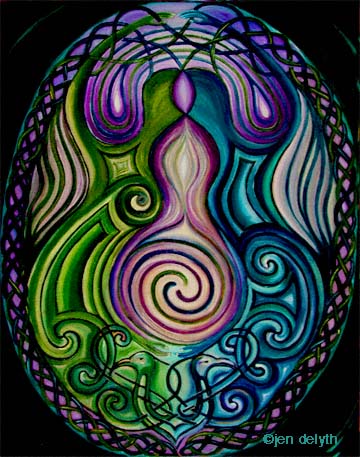To Mean or Not to Mean
Posted to a discussion of Celtic
Art by Jen Delyth, 6 August 2002 at
http://groups.yahoo.com/group/Celtic_Art/

|
In our circling spiraling way, we always come
back to this discussion of "meaning" or "not meaning". I
think we need to clarify that some Celtic patterns "mean" something,
and others not... This is a multilayered issue, and not simply answered..
Some (ancient) Celtic patterns have symbolic intended "meaning" which
can be strongly deduced by the context in which they are found, folkloric anthropological
evidence etc. Other patterns may have originally been intended to have symbolic
meaning, but we'll never know what it was exactly. Some patterns are used in a
purely decorative function way, and others are a mixture of being used
decoratively, within a tradition where originally the patterns did have some
significance.
As contemporary Celtic artists, some of us intend an underlying
"meaning" in our work, using the "language" of Celtic
knotwork (including animal symbols).. Others of us work intuitively with a
strong sense of using the patterns with resonance to the symbols inherent
"meaning", but in a more open fluid non specific way. Some of us work
with a functional decorative intention with the patterns, using the aesthetic
and design to balance beauty and form within a piece. (I think especially for
jewelers than for painters, this is more likely to cause frustration when the
public is constantly demanding a "meaning" for a lovely knotwork
pattern that is designed for its balance, and aesthetic qualities rather than as
talismanic power objects. Other jewelers are specifically using some patterns in
a symbolic way as their pieces are intended to be received and worn as
talismans..... And sometimes a mixture of all the above...
|
I don't think we should disrespect our customers for asking, or seeking an
underlying profundity to Celtic patterning used in our work... It is
understandable considering the context in which "Celtic" art is
usually found (religious illuminated manuscripts) and its appearance on stones
that seem to have sacred significance. It is frustrating though, and
particularly for the sense of superficiality that this question sometimes provokes.
I recognize the hunger in people for things to have "meaning" is
perhaps a
reflection of the spiritual void in our society I sometimes think.... So, my
point is, some spirals mean something (historically, and if used by an artist to
resonate as an abstract symbol or movement, change, flow etc) , and others are
used purely decoratively within the page or as the perfect shape to hold a stone
in a ring for example... Neither is the correct approach, both are.
However, it is my feeling, that all spirals do have their own intrinsic
energetic value within their aesthetic functional form... whether implied,
intended or not....
So! To mean or not to mean? This is the question.... and what is that Zen
riddle? "If a tree falls in a forest but no one is there to hear it,
does it make a sound?" I think spirals are powerful meaningful
symbols of natural energy and rhythm of the Universe - more than any other
abstract two dimensional "marks" made by people - they are archetypal,
and have profound "meaning" within the context in which they are used,
and also possibly independently..... They are used universally by people
throughout the ages, and are intuitively applied by people to represent inner consciousness
(as in Jung's work suggests with the paintings of patients dealing with
psychosis). Neolithic artists certainly used spirals with profound intention of
their representing or perhaps even actively attracting or channeling powerful
energies... but then spirals are the special sacred pattern of life.... as well
as beautiful flowing paths that we love to draw..... Jen
--
Y gwir yn erbyn y byd - Truth against the world
Jen Delyth ~ Keltic Designs http://www.kelticdesigns.com
Return to The
Symbolism of Celtic Design
